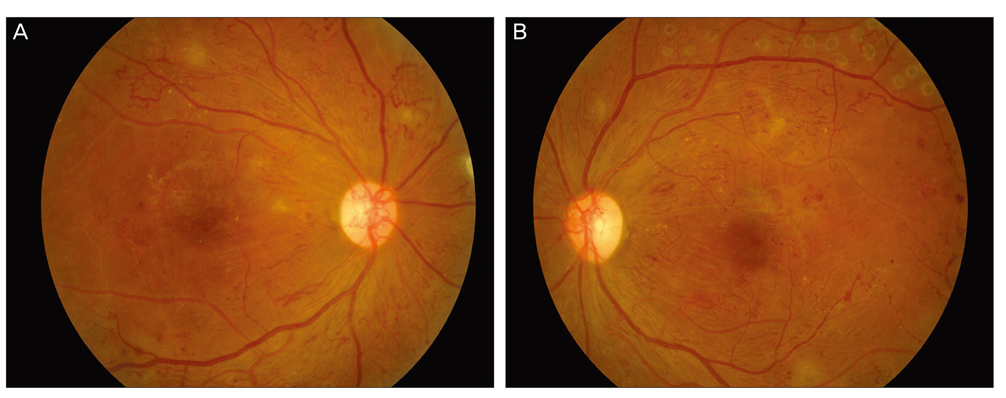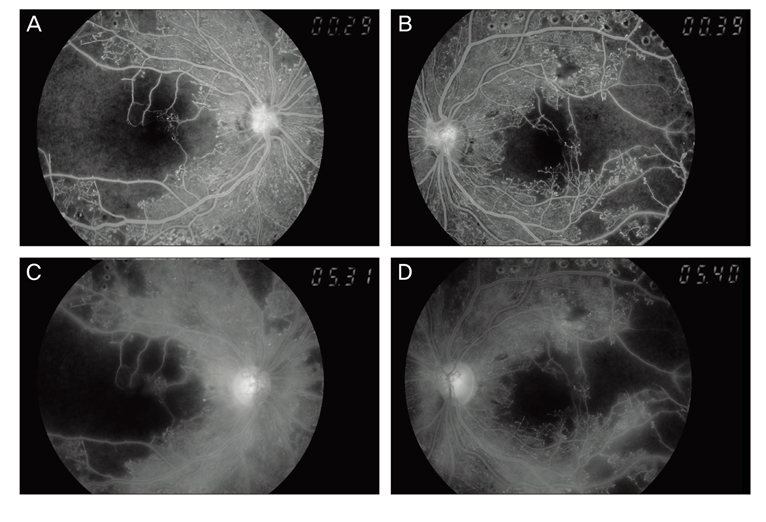Korean J Ophthalmol.
2012 Apr;26(2):147-150. 10.3341/kjo.2012.26.2.147.
Pegylated Interferon-Associated Severe Retinopathy in a Patient with Chronic Hepatitis
- Affiliations
-
- 1Konyang University Kim's Eye Hospital, Seoul, Korea.
- 2Department of Ophthalmology, Chuncheon Sacred Heart Hospital, Hallym University College of Medicine, Chuncheon, Korea. mcshin@hallym.ac.kr
- KMID: 1364871
- DOI: http://doi.org/10.3341/kjo.2012.26.2.147
Abstract
- This paper reports a case of pegylated interferon-associated retinopathy in a patient with chronic hepatitis C. A 32-year-old female with chronic hepatitis C undergoing pegylated interferon and ribavirin combination therapy complained of visual blurring. Features of interferon-associated retinopathy, including ocular complications such as cotton wool spots, retinal hemorrhages, macular edema, and branch retinal vein occlusion, were found in the fundus of both of her eyes. Pegylated interferon combination therapy was stopped, and the retinopathy of the patient was treated with intravitreal bevacizumab injections and panretinal photocoagulations. This case shows that pharmacokinetically improved pegylated interferon has ocular complications for patients with chronic hepatitis C. Accordingly, patients undergoing pegylated interferon treatment for hepatitis C need regular eye examinations for protection of their vision.
MeSH Terms
-
Adult
Angiogenesis Inhibitors/therapeutic use
Antibodies, Monoclonal, Humanized/therapeutic use
Antiviral Agents/*adverse effects
Female
Hepatitis C, Chronic/*drug therapy
Humans
Interferon-alpha/*adverse effects
Polyethylene Glycols/*adverse effects
Recombinant Proteins/adverse effects
Retinitis/*chemically induced/drug therapy
Severity of Illness Index
Figure
Reference
-
1. Hayasaka S, Nagaki Y, Matsumoto M, Sato S. Interferon associated retinopathy. Br J Ophthalmol. 1998. 82:323–325.2. Goncalves LL, Farias AQ, Gonçalves PL, et al. Branch retinal vein thrombosis and visual loss probably associated with pegylated interferon therapy of chronic hepatitis C. World J Gastroenterol. 2006. 12:4602–4603.3. Malik NN, Sheth HG, Ackerman N, et al. A prospective study of change in visual function in patients treated with pegylated interferon alpha for hepatitis C in the UK. Br J Ophthalmol. 2008. 92:256–258.4. Jain K, Lam WC, Waheeb S, et al. Retinopathy in chronic hepatitis C patients during interferon treatment with ribavirin. Br J Ophthalmol. 2001. 85:1171–1173.5. Hayasaka S, Fujii M, Yamamoto Y, et al. Retinopathy and subconjunctival haemorrhage in patients with chronic viral hepatitis receiving interferon alfa. Br J Ophthalmol. 1995. 79:150–152.6. Okuse C, Yotsuyanagi H, Nagase Y, et al. Risk factors for retinopathy associated with interferon alpha-2b and ribavirin combination therapy in patients with chronic hepatitis C. World J Gastroenterol. 2006. 12:3756–3759.7. Nagaoka T, Sato E, Takahashi A, et al. Retinal circulatory changes associated with interferon-induced retinopathy in patients with hepatitis C. Invest Ophthalmol Vis Sci. 2007. 48:368–375.8. Manesis EK, Petrou C, Brouzas D, Hadziyannis S. Optic tract neuropathy complicating low-dose interferon treatment. J Hepatol. 1994. 21:474–477.9. Ayaki M. Development of neovascular glaucoma in the course of interferon alfa therapy for hepatitis type C. Br J Ophthalmol. 1994. 78:238.10. Tu KL, Bowyer J, Schofield K, Harding S. Severe interferon associated retinopathy. Br J Ophthalmol. 2003. 87:247–248.
- Full Text Links
- Actions
-
Cited
- CITED
-
- Close
- Share
- Similar articles
-
- Pegylated Interferon Associated Retinopathy in Chronic Hepatitis Patients
- Alopecia Areata in a Patient Treated with Interferon Alpha-2a for Chronic Hepatitis B
- A Case of Cutaneous Sarcoidosis Associated with Pegylated Interferon Alpha-2a and Ribavirin Therapy
- A Case of Vitiligo in a Hepatitis C Patient after Pegylated Interferon Treatment
- Thymosin Alpha-1 in Combination with Pegylated Interferon and Ribavirin in Chronic Hepatitis C Patients Who have Failed to Prior Pegylated Interferon and Ribavirin Treatment





